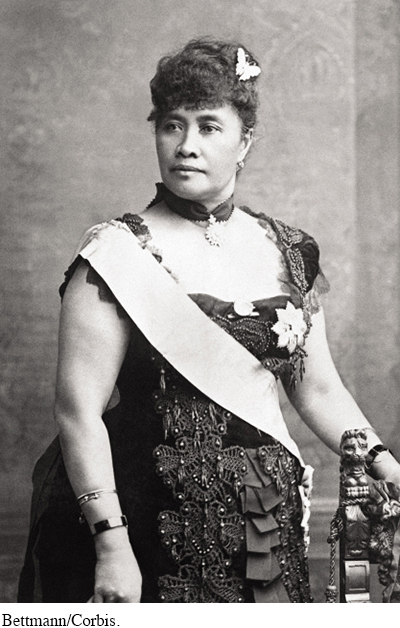The American Promise: Printed Page 574
BEYOND AMERICA’S BORDERS
The American Promise: Printed Page 574
Page 574Regime Change in Hawai’i
Queen Lili’uokalani came to the throne in Hawai’i in 1891 determined to take back power for her monarchy and her people. As a member of Hawai’i’s native royalty, or ali’i, she had received a first-
American missionaries first came to Hawai’i in 1820. Some intermarried with their Christian converts, creating a group of hapa haole (half whites), as well as a growing number of children born in Hawai’i to white parents. The temptations of wealth led many missionaries, like Amos Starr Cooke, to acquire land and take up sugar planting. In 1851, he founded Castle & Cooke, which became one of the world’s largest sugar producers. By the end of the century, missionaries and planters had blended into one ruling class and gained control of extensive tracts of land. Thanks to the “Bayonet Constitution,” they controlled the islands, even though native Hawai’ians and the Japanese and Chinese laborers imported to work on the sugar plantations outnumbered them ten to one.
Sugar became a booming business in Hawai’i as a result of favorable reciprocity treaties with the United States. But hard times came to the islands with the passage of the McKinley tariff in 1890. The tariff wiped out the advantage Hawai’ian sugar had enjoyed in the American market, with devastating results. Within two years, the value of Hawai’ian sugar exports plummeted from $13 million to $8 million.
One way to avoid the tariff was by incorporating Hawai’i into the United States through annexation. Foremost among those who championed this scheme was Lorrin Thurston, the thirty-

Queen Lili’uokalani picked Saturday, January 14, 1893, as the day to promulgate her new constitution. Her aim was to return Hawai’i to Hawai’ians by allowing only those with native ancestry the right to vote. Learning of her intentions, Thurston quickly hatched a plot to overthrow the monarchy. Late that night, he called on John L. Stevens, the American minister to Hawai’i. Laying out his plan, he urged Stevens, a staunch annexationist, to support the overthrow of the queen and to pledge U.S. support for Thurston’s actions. Without hesitating, Stevens promised to land Marines from the USS Boston “to protect American lives and property.”
Two days later, 162 American Marines and sailors marched into Honolulu armed with carbines, howitzers (small cannons), and Gatling guns. The next day, Thurston and 17 of his confederates seized control of a government building and proclaimed themselves a “provisional government.” Minister Stevens promptly recognized the revolutionaries as the legitimate government of Hawai’i.
To avoid bloodshed, Queen Lili’uokalani agreed to step aside. But in a masterstroke, she composed a letter addressed not to her enemies in the provisional government, but to the U.S. government. Protesting her overthrow, she yielded her authority “until such time as the Government of the United States, shall, upon the facts being presented to it, undo the action of its representatives and reinstate me in the authority which I claim as the constitutional sovereign of the Hawai’ian Islands.” The action now shifted to Washington, where Grover Cleveland, a Democrat skeptical of America’s adventures abroad, quickly squelched plans for annexation and supported the Hawai’ian queen. The provisional government, however, enjoyed the support of Republicans in Congress and refused to step down, biding its time, waiting for the Republicans to take back the White House.
In 1898, as the taste for empire swept the United States in the wake of the Spanish-
“Hawai’i is ours,” Grover Cleveland wrote sadly. “As I look back upon the first steps in this miserable business, and as I contemplate the means used to complete the outrage, I am ashamed of the whole affair.”
Questions for Analysis
Summarize the Argument: How did the government of Queen Lili’uokalani come to be overthrown in 1893?
Consider the Context: How did economic issues on the mainland affect the status of Hawai’i?
Recognize Viewpoints: What role did party politics play in the annexation of Hawai’i?